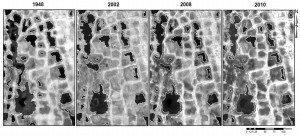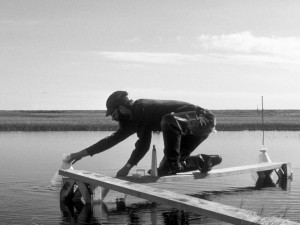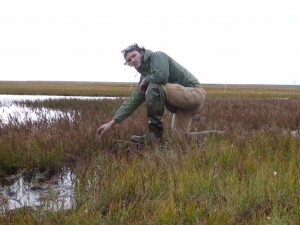12 March 2015
WASHINGTON, D.C. – Ponds in the Arctic tundra are shrinking and slowly disappearing, according to a new study.

Satellite images show how Arctic ponds have slowly decreased in size since 1948.
Credit: Christian Andresen
More than 2,800 Arctic tundra ponds in the northern region of Alaska’s Barrow Peninsula were analyzed using historical photos and satellite images taken between 1948 and 2010. Over the 62-year period, the researchers found that the number of ponds in the region had decreased by about 17 percent, while pond size had shrunk by an average of one-third.
“The 17 percent is a very conservative estimate because we didn’t consider ponds that had divided, or split into two ponds,” explained Christian Andresen, a postdoctoral fellow at the University of Texas at El Paso (UTEP) who led the study. “Some ponds are elongated and as they shrink over time, they can be divided into two or more smaller ponds.”
The study, which has been accepted for publication in the Journal of Geophysical Research: Biogeosciences, a journal of the American Geophysical Union, was conducted by Andresen and UTEP Associate Professor of Biological Sciences Vanessa Lougheed.
The team points to warming temperatures and encroaching plants as one of the reasons the ponds are disappearing. As temperatures rise, nutrient-rich permafrost — a frozen layer of soil — thaws, releasing nutrients into ponds and enhancing plant growth.
“Plants are taking over shallow ponds because they’re becoming warm and nutrient-rich,” Andresen said. “Before you know it, boom, the pond is gone.”


Photos depict how an Arctic pond in Alaska has become overcome by plant growth in the span of 36 years.
Credit: Christian Andresen
Andresen worries that the geomorphology of the region’s landscape will change if these small bodies of water continue to shrink.
“The role of ponds in the Arctic is extremely important,” he said. “History tells us that ponds tend to enlarge over hundreds of years and eventually become lakes; ponds shape much of this landscape in the long run, and with no ponds there will be no lakes for this region.”
Ponds in the Barrow Peninsula also serve as a major food source and nesting habitat for migratory birds, including certain waterfowl on the threatened species list, such as the spectacled eider (Somateria fischeri) and Steller’s eider (Polysticta stelleri). If the aquatic system continues to shift toward a drier community, their vital summer feeding and nesting grounds could disappear, affecting the future of these and many other migratory species, according to the study’s authors.
###
The American Geophysical Union is dedicated to advancing the Earth and space sciences for the benefit of humanity through its scholarly publications, conferences, and outreach programs. AGU is a not-for-profit, professional, scientific organization representing more than 60,000 members in 139 countries. Join the conversation onFacebook, Twitter, YouTube, and our other social media channels.
Notes for Journalists
Journalists and public information officers (PIOs) of educational and scientific institutions who have registered with AGU can download a PDF copy of this article by clicking on this link: http://onlinelibrary.wiley.com/doi/10.1002/2014JG002778/abstract
Or, you may order a copy of the final paper by emailing your request to Nanci Bompey at [email protected]. Please provide your name, the name of your publication, and your phone number.
Neither the paper nor this press release is under embargo.
“Disappearing Arctic tundra ponds: Fine-scale analysis of surface hydrology in drained thaw lake basins over a 65 year period (1948-2013)”
Authors:
Christian G. Andresen: Environmental Science and Engineering Program, University of Texas at El Paso, El Paso, TX, USA;
Vanessa L. Lougheed: Department of Biological Sciences, University of Texas at El Paso, El Paso, TX, USA.
Contact Information for the Authors:
Christian G. Andresen: [email protected]
Nanci Bompey
+1 (202) 777-7524
[email protected]
University of Texas at El Paso Contact:
Veronique Masterson
+1 (915) 747-5526
[email protected]